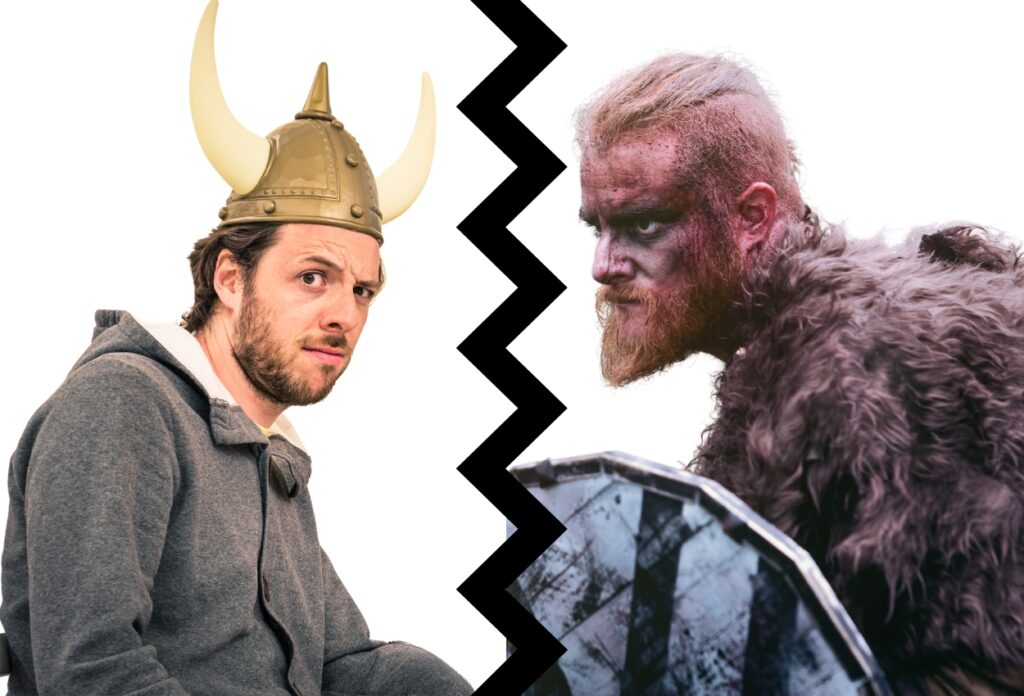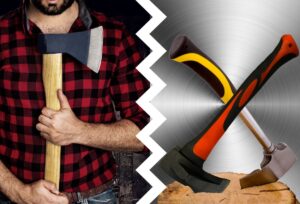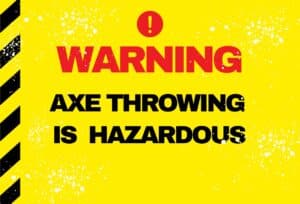Vikings and Axes. As Authentic as Pineapple on Pizza.
Is the Vikings theme really a relevant one for modern axe throwing? Let’s take a look at both sides.

“Viking Axe Throwing”, “Viking Games”, “Release your inner Viking”, “Throw like a Viking”. The Vikings concept is pervasive in the contemporary axe throwing scene, such that the idea is not at all controversial – until now?
Is the Viking theme really a relevant one for axe throwing? Let’s take a look at both sides of the argument in this Bury the Hatchet feature.
The key argument against a “Vikings axe throwing” theme is that there is zero historical evidence that Vikings ever threw axes!
That being the case, they make poor ambassadors for the sport.
Axes and Vikings are closely linked though (albeit not for throwing). Axes were a prominent part of Viking culture.
It is true that Vikings commonly used axes. An axe was a useful tool for cutting wood and the like. It could also easily be turned into a weapon (particularly if the owner couldn’t afford a sword).
Large two-handed axes were used prolifically in war. It is not inconceivable that some could have been thrown about!
The Dane axe, popularised by the Viking Age and often used in battle, was a huge, 1.5m long axe, weighing over 2kg, wielded in two hands. Axe throwers today, even those that use larger axes, don’t use anything like that, preferring forestry axes, hatchets or tomahawks.
Smaller Viking axes have also been discovered, such as the Mammen axe found in a Danish barrow.
Smaller hand axes, like the Mammen axe, were carved with intricate silver decoration on the iron axe. They were not likely to have been chucked about!
Regardless, there is a widely held understanding that Vikings and axes are closely linked, even when the average person has never investigated the idea with academic rigour.
This adds authenticity to using their “brand” as a motif for axe throwing. If an axe throwing venue is advertised using this Viking motif, it is not considered a strange thing.
On the other hand, advertising Viking spear throwing would be considered very strange (despite the fact that Vikings are more likely to have thrown spears than axes).
The whole idea of linking Vikings to axe throwing is to ascribe some sort of ancient mystique to the sport. As though by entering into the sport today you are joining a long line of axe throwers throughout the ages, like the Vikings.
It is a fallacy that contemporary axe throwing has a long history. At best throwing axes has been done at intermittent periods throughout history, and, for sport, only since the Twentieth Century.
Axe throwing as a sport does have a relatively short history, but there is an underlying primal spirit inherent in axe throwing, which has pervaded throughout the ages.
The idea of a “Viking” in contemporary thought embodies this spirit of physical adventure, risk and challenge – and therefore fits perfectly with the sport of axe throwing.
If we ignored that the sport of axe throwing is a modern invention, it would make far more sense to link axe throwing with the more ancient Franks. They, at least, threw axes in battle, and preceded the Viking Age by 400 years.
For whatever reason, Vikings have invaded popular culture like few other groups. Most people have an understanding of the “Vikings” that fits well with the spirit of axe throwing.
This understanding may well be inconsistent with the historical seagoing raiders from Scandinavia, from about 800 to 1100 CE. But does that really matter?
It is also unhelpful to associate the skilful, inclusive sport of axe throwing with the aggressive behaviour of the Viking raiders who pillaged Europe in the Middle Ages.
In particular, the “Viking” motif emphasises a distinctly male machismo (Viking raiders being exclusively male), something that is not reflected in the modern sport, fortunately.
Axe throwing is fun as well as being fiercely competitive sometimes.
Axe throwing is skilful and fun, but there is obviously a physical element too, which throwers enjoy.
Axe throwers don’t need to be immensely strong (although strength undoubtedly helps the large axe/double bit throwers).
But there is a physical, forceful mindset needed to launch a heavy bladed object into a target. An attitude very much in sync with the perceived spirit of the Vikings.
Anyone who has ever thrown an axe could easily imagine a 10th century Viking warrior doing the exact same thing!
Ok, photo-ops with Viking horns aren’t going to hurt anyone, but there are much better traditions to promote the true spirit and tradition of axe throwing (the lumberjack tradition springs to mind for example).
Most people would think it strange if the local gun club started advertising “unleash your inner Cowboy” to sell shooting, or the athletics club started recruiting javelin competitors with the slogan “throw like a Spartan”.
If axe throwing wants to be taken seriously then it needs to dump the Vikings!
Horns are a good example of where the modern perception of Vikings differs from the real historical people. Most people know that Vikings never wore horns on their helmets in real life, but that doesn’t stop them recognising such helmets as being distinctly “Viking”.
Not everyone agrees pineapple should be on a pizza, but that is still a concept that people instantly recognise (for good or bad).
The “Viking axe throwing” theme is one that is easily recognised (regardless of historical accuracy), and, far from being a negative for the sport, is readily embraced around the world.







